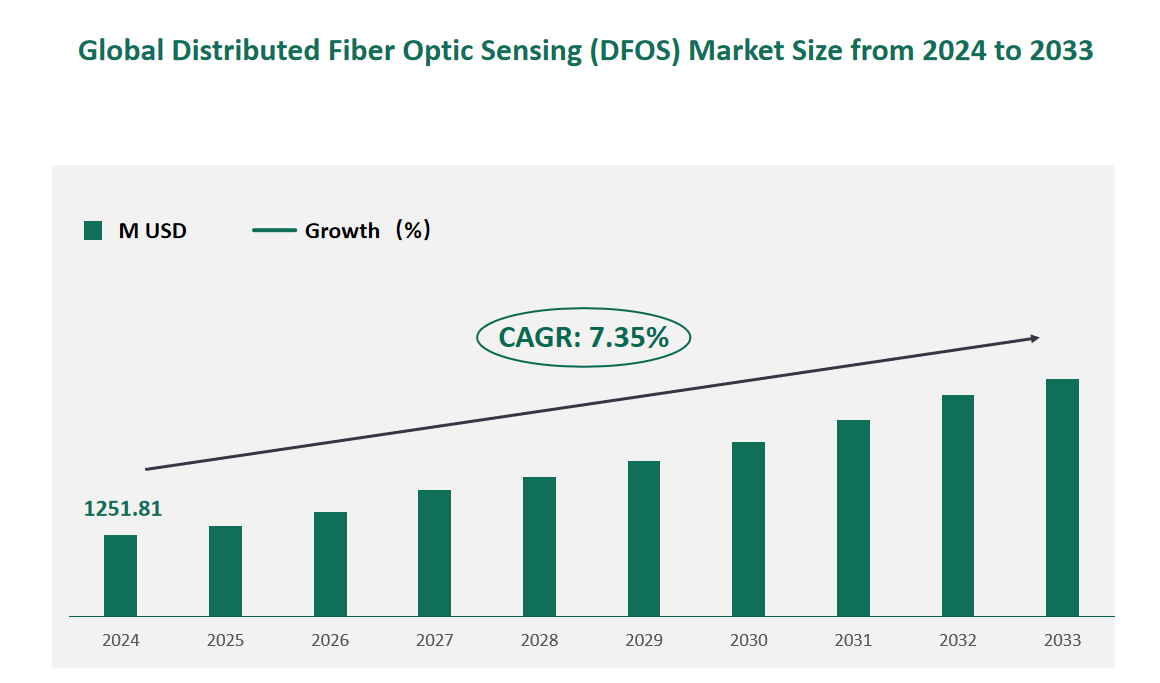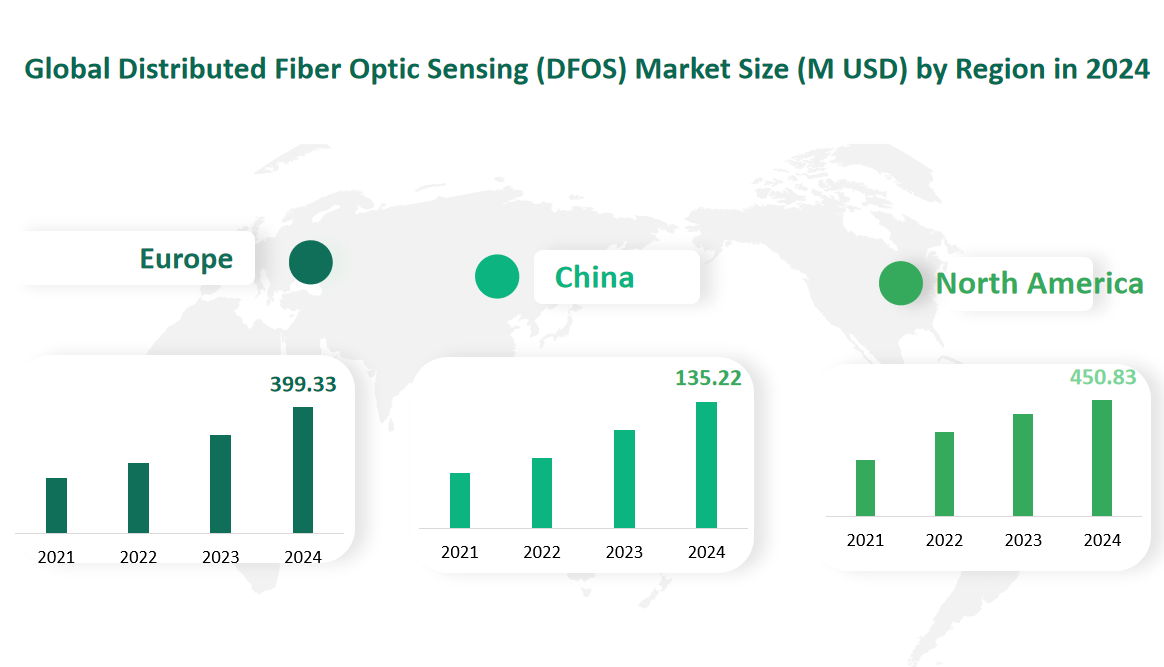1 Global Distributed Fiber Optic Sensing (DFOS) Market Size (Value) and CAGR (2024-2033)
In 2024, the global Distributed Fiber Optic Sensing (DFOS) market was valued at USD 1,251.81 million, with a CAGR of 7.35% from 2024 to 2033.
Distributed Fiber Optic Sensing (DFOS) systems utilize optical fibers as sensors, enabling the detection of temperature, strain, and acoustic vibrations along the entire length of the fiber. This technology is particularly valuable in applications such as power transmission, oil and gas pipelines, infrastructure monitoring, and security systems, where traditional point sensors are insufficient or impractical.
Figure Global Distributed Fiber Optic Sensing (DFOS) Market Size (M USD) and CAGR 2024-2033

2 Distributed Fiber Optic Sensing (DFOS) Market Drivers
Wide Range of Applications
One of the primary drivers of the DFOS market is its extensive range of applications. DFOS technology is used in critical sectors such as power cable monitoring, fire and heat detection, pipeline and LNG monitoring, well and reservoir monitoring, rail monitoring, perimeter security, and geohydrological applications. The ability to provide real-time, continuous monitoring over long distances makes DFOS an ideal solution for industries that require high levels of safety and reliability. For instance, in the oil and gas sector, DFOS is increasingly being adopted for leak detection and flow rate monitoring in pipelines, enhancing operational efficiency and safety.
Strict Regulations and Government Support
Another significant driver is the increasing regulatory focus on safety and environmental monitoring. Governments in developed regions such as North America and Europe have implemented stringent regulations to ensure environmental compliance and safety standards. These regulations have spurred the adoption of DFOS technologies, which offer precise and continuous monitoring capabilities. Emerging economies are also strengthening their environmental monitoring guidelines, further driving demand for DFOS solutions.
Technological Advancements
Continuous technological advancements are another key driver for the DFOS market. The integration of 5G technology, which relies heavily on fiber optic networks, is expected to boost the demand for DFOS systems. The high data speeds and reliability of 5G networks require robust fiber connectivity, making DFOS an essential component for infrastructure monitoring.
3 Distributed Fiber Optic Sensing (DFOS) Market Challenges
Fluctuations in Raw Material Prices
Another significant challenge is the fluctuation in raw material prices. The cost of key components such as optical fibers, connectors, and semiconductor optical amplifiers can have a substantial impact on the overall cost of DFOS systems. These fluctuations can affect the profitability of manufacturers and make it difficult to maintain stable pricing for end-users. As the demand for DFOS systems increases, the supply of raw materials may struggle to keep pace, leading to further price volatility.
Technical Complexity and Installation Challenges
The technical complexity of DFOS systems poses another challenge for market growth. The installation and operation of DFOS systems require specialized knowledge and skills, which can be a barrier to adoption for some potential users. The need for precise calibration and maintenance of these systems can also add to the overall cost and complexity. Additionally, the high initial investment required for DFOS systems can deter smaller companies and organizations from adopting the technology.
Lack of Awareness and Market Education
A lack of awareness about the benefits and capabilities of DFOS systems among potential end-users is another significant challenge. Many industries are still unfamiliar with the advantages of DFOS over traditional sensing technologies, leading to slower adoption rates. Market education and awareness campaigns are essential to highlight the value proposition of DFOS systems, particularly in emerging markets where the technology is less known.
4 Global Distributed Fiber Optic Sensing (DFOS) Market Size and Share by Type in 2024
DTS is one of the most widely used types of DFOS technology. It utilizes the Raman effect to measure temperature along the entire length of an optical fiber. The market size for DTS in 2024 is projected to be $674.96 million USD. This technology is particularly valuable in applications such as power cable monitoring, fire detection, and LNG storage monitoring. DTS systems can provide real-time temperature profiles over long distances, making them ideal for industries that require high levels of safety and reliability. The ability to detect temperature changes with high spatial resolution allows for early detection of potential hazards, such as overheating in power cables or fires in tunnels.
DAS is another significant segment of the DFOS market, with a projected market size of $339.99 million USD in 2024. DAS technology detects acoustic vibrations along the fiber, making it highly effective for applications such as pipeline monitoring, perimeter security, and seismic event detection. DAS systems can capture real-time data on vibrations and acoustic signals, enabling operators to detect and locate events such as leaks, cable faults, or intrusions. The high sensitivity and real-time monitoring capabilities of DAS make it a preferred choice for industries that require robust security and monitoring solutions.
Table Global Distributed Fiber Optic Sensing (DFOS) Market Size and Share by Type in 2024
Type | Market Size (M USD) 2024 | Market Share 2024 |
DTS | 674.96 | 53.92% |
DAS | 339.99 | 27.16% |
Others | 236.86 | 18.92% |
5 Global Distributed Fiber Optic Sensing (DFOS) Market Size and Share by Application in 2024
The power industry is a major application area for DFOS, with a projected market size of 221.38 million USD in 2024. DFOS systems are used for monitoring power cables, detecting overheating, and ensuring the safe operation of electrical grids. These systems provide real-time temperature profiles and strain measurements, which are crucial for preventing power outages and maintaining grid reliability.
The application of DFOS in bridges and tunnels is also significant, with a market size of 296.85 million USD in 2024. These systems are used for structural health monitoring, detecting deformations, and ensuring the safety of critical infrastructure. DFOS provides continuous monitoring along the entire length of bridges and tunnels, offering early warning of potential issues and enabling timely maintenance.
The petrochemical industry is another key application area, with a market size of 570.24 million USD in 2024. DFOS is used for monitoring pipelines, storage tanks, and other critical assets. These systems detect leaks, temperature changes, and mechanical strains, ensuring the safe operation of petrochemical facilities and preventing environmental disasters.
Table Global Distributed Fiber Optic Sensing (DFOS) Market Size and Share by Application in 2024
Application | Market Size (M USD) 2024 | Market Share 2024 |
Power Industry | 221.38 | 17.68% |
Bridges and Tunnels | 296.85 | 23.71% |
Petrochemical Industry | 570.24 | 45.55% |
Others | 163.33 | 13.05% |
6 Global Distributed Fiber Optic Sensing (DFOS) Market Size by Region in 2024
North America is a significant region for the DFOS market, with a projected market size of 450.83 million USD in 2024. The region’s market growth is driven by the extensive use of DFOS in the oil and gas industry, power transmission, and infrastructure monitoring. The United States, in particular, has a large network of energy pipelines, making it a key market for DFOS applications. Additionally, technological advancements and stringent safety regulations further support the adoption of DFOS in North America.
Europe is another major region, with a projected market size of 399.33 million USD in 2024. The region’s market growth is driven by the increasing demand for DFOS in the power and petrochemical industries. European countries are also at the forefront of adopting advanced sensing technologies for environmental monitoring and infrastructure safety. The presence of major DFOS manufacturers and the focus on innovation further contribute to the region’s market growth.
China is expected to witness significant growth in the DFOS market, with a projected size of $135.22 million USD in 2024. The region’s market growth is driven by rapid infrastructure development, increasing investments in the power and petrochemical sectors, and the adoption of advanced monitoring technologies. The region’s growth is also supported by government initiatives to enhance infrastructure safety and reliability.
Figure Global Distributed Fiber Optic Sensing (DFOS) Market Size by Region in 2024

7 Major Players in Global Distributed Fiber Optic Sensing (DFOS) Market
7.1 Schlumberger
Company Profile:
Schlumberger is a leading multinational company specializing in technology for reservoir characterization, drilling, production, and processing in the oil and gas industry. Established in 1926, the company is headquartered in Houston, Texas, with manufacturing bases primarily in North America and Asia. Schlumberger operates globally, focusing on providing comprehensive solutions for the oil and gas sector.
Business Overview:
Schlumberger’s business segments include Reservoir Characterization, Drilling, Production, and Cameron Group. The company offers a wide range of technologies and services aimed at optimizing the entire lifecycle of oil and gas reservoirs. Schlumberger’s DFOS solutions are particularly notable for their advanced capabilities in distributed temperature sensing (DTS) and distributed acoustic sensing (DAS), which are used for monitoring and optimizing operations in harsh environments.
Products Offered:
Schlumberger’s DFOS products include short-range DTS systems designed for cryogenic leak detection, subsea riser monitoring, and power transmission cable monitoring. These systems leverage the Raman backscatter principle to provide real-time temperature profiles and fault detection capabilities. The company’s products are known for their high reliability, reduced hardware requirements, and compatibility with multiple fiber types.
Recent Financial Data:
In the most recent year, Schlumberger reported DFOS sales of 2289 units, generating a revenue of 85.26 million USD.
7.2 Halliburton
Company Profile:
Halliburton, founded in 1919, is a major provider of services and products to the upstream oil and natural gas industry. Headquartered in Houston, Texas, the company operates primarily in North America but has a global presence. Halliburton’s business is divided into two main segments: Completion and Production, and Drilling and Evaluation.
Business Overview:
Halliburton’s Completion and Production segment offers cementing, stimulation, intervention, and pressure control services, while the Drilling and Evaluation segment provides field and reservoir modeling, drilling, and wellbore placement solutions. Halliburton’s DFOS solutions are designed to enhance fracture monitoring and improve operational efficiency in the oil and gas industry.
Products Offered:
Halliburton’s DFOS products include fracture monitoring solutions that combine DTS and DAS technologies. These systems provide real-time insights into subsurface conditions, enabling operators to optimize fracture placement and performance. Halliburton’s products are known for their robustness and ability to deliver actionable data in challenging environments.
Recent Financial Data:
Halliburton reported DFOS sales of 1799 units in the most recent year, generating a revenue of 61.81 million USD.
7.3 Baker Hughes
Company Profile:
Baker Hughes, established in 1907, is a prominent oilfield services company headquartered in Houston, Texas. The company operates globally, offering a wide range of oilfield products, services, and digital solutions. Baker Hughes’ business segments include Oilfield Services (OFS), Oilfield Equipment (OFE), Turbomachinery & Process Solutions (TPS), and Digital Solutions (DS).
Business Overview:
Baker Hughes’ OFS segment provides comprehensive solutions for drilling, evaluation, completion, production, and intervention. The OFE segment offers essential products for facilitating hydrocarbon flow from subsea wellheads to surface facilities. The TPS segment focuses on equipment for mechanical-drive, compression, and power-generation applications, while the DS segment provides operating technologies for asset-intensive industries.
Products Offered:
Baker Hughes’ DFOS products include the SureVIEW optical well monitoring system, which integrates DTS and DAS technologies. These systems provide thermal and acoustic profiles of the wellbore, enabling optimized gas lift, stimulation, and production operations. Baker Hughes’ products are designed to enhance operational efficiency and reduce operating costs in the oil and gas industry.
Recent Financial Data:
In the most recent year, Baker Hughes reported DFOS sales of 1005 units, generating a revenue of 36.35 million USD.

